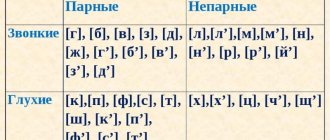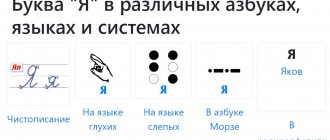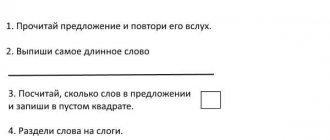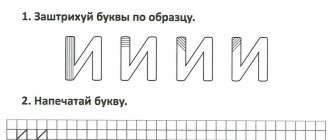- home
- Directories
- Handbook of Russian for elementary school
- Sounds and letters
- Consonant sounds and letters representing them
- Soft and hard consonants
Consonants can be hard or soft .
Many consonants are paired in softness-hardness , i.e. in different words they can soften or become hard. In transcription, the softness of a consonant is indicated by the [ ' ] symbol.
Table of consonant sounds, paired and unpaired by hardness/softness:
| Consonant clusters | Doubles | Unpaired |
| Solid | [b], [c], [d], [d], [h], [k], [l], [m], [n], [p], [p], [s], [t ], [f], [x] | [zh], [w], [ts] |
| Soft | [b'], [c'], [g'], [d'], [z'], [k'], [l'], [m'], [n'], [p'], [p'], [s'], [t'], [f'], [x'] | [th'], [h'], [h'] |
In writing, the hardness of consonant sounds is indicated by the vowels a, o, u, ы, e (which come after the consonant sound) - park [ park], rota [ rota ] , puma [ puma ], kry nka [little jar], s er [sir].
The softness of consonant sounds in writing is indicated by:
- soft sign - shallow [ m'el'], pal that [pal'to], written [ p'is'm'eny']
- vowels e, e, i, yu, i - p e n [p'en'], sv e kla [sv'okla], p i t [p'it'], k l u in [kl'uv], pl i ska [pl'aska].
In addition, consonant sounds paired in hardness/softness can be softened before some soft consonants - z [z'] , s [s'] , n [n'] , t [t'] , l [l'] .
For example: pes n ya [p'es'n'a], es l i[y'es'l'i], tail ik [khvos't'ik] and others.
Also, the consonant [n'] will be soft before the consonant letters ch and shch , while a soft sign is not written between them: donut [pon'ch'ik], racer [gon'sch'ik].
Remember that consonants unpaired in hardness-softness remain only hard or only soft (regardless of whether there is a soft sign after them or what vowel follows them).
Hard unpaired consonants always remain hard.
For example:
[zh] - heat [heat], yellow [yellow']
[sh] - ball [ball], sew [shy'u]
[ts] - heron [heron], circus [circus]
Soft unpaired consonants always remain soft.
For example:
[th'] - yogurt [y'ogurt], my [my']
[h'] - hour [h'as], check [ch'ek]
[sch'] - pike [sch'uka], gap [sch'el']
Share with friends on social networks:
How are hissing sounds produced?
You already know that consonant sounds are formed when air passes through various barriers in the oral cavity: lips, teeth, tongue. When overcoming obstacles, noise is produced. Some consonants have a voice added to the noise. Therefore, we distinguish between voiceless consonants (formed only from noise) and voiced consonants (obtained by combining voice and noise). Examples: voiceless consonants are t, f, s, voiced consonants are d, v, z.
Hissing sounds also belong to consonants. They are placed in a separate group due to their educational characteristics.
Let's take a walk through the Magic Forest and get to know the hissing sounds in detail. Many animals and birds live in the huge Magic Forest. Take a look around.
Here in the clearing a hedgehog is trying to catch a dragonfly, and the hedgehogs are playing hide and seek near a tree stump. Nearby, a hare is looking after her little bunnies, and they are cheerfully whispering about something.
In a forest lake, a predatory fish, the pike, has gone hunting, and the spiny fish, the ruffe, is learning to swim long distances.
But an important titmouse bird sat down on a cherry tree branch. She carefully watches the guests of the forest.
Guys, say the words out loud:
- hedgehog, hedgehog, important;
- hare, hares, prickly, bird, titmouse;
- predatory, pike;
- ruff, cherry.
What consonant sound is there in each word in the line numbered 1? (sound [zh]). On the line number 2? (sound [h]). Under the number 3? ([sch]). Under the number 4? ([w]). These sounds: Zh, Ch, Shch, Sh are called hissing consonant sounds.
If you listen closely, you can hear these sounds in our forest. A bumblebee flew by. How does it buzz?
A snake slithered through the grass. She saw the danger and hissed.
The sparrows are noisily discussing something.
The squirrel cracks nuts.
There are many of these sounds in the world around us. Why are they called hissing? Let's listen to what the Wise Owl will explain to us about this.
Hissing sounds are divided into voiced and unvoiced.
The sound [zh] is pronounced with the participation of noise and voice: zh-zh-zh. It is ringing: heat, buzzing, yellow.
And the sounds [ch'], [sh], [sh'] are formed with the participation of only noise, so they are dull: a cup, a hut, a sliver.
The hissing zh–sh form a pair in terms of sonority and deafness: heat-shar, pity-shawl, gesture-six. The sounds h, sch do not have a pair in terms of voiceness.
In terms of softness and hardness, not a single sibilant forms a pair with other consonants. The hissing sounds [zh], [sh] are always hard consonants: beetle [beetle], rustle [shorah].
The sounds of soft consonants in all situations are produced by hissing [ch'], [sch']: hours [ch'asy], brush [sh'otka].
Distinctive features of soft and hard sounds
What sound comes after a consonant:
- If after a consonant there is a vowel a, o, u, e, s, then the consonant is hard.
- If after a consonant there is a vowel and, e, yu, i, then the consonant is soft.
Practice with examples: In the words “mother” and “nora” the consonants are hard, because they are followed by “a” and “o”. In the words “fly” and “nanny” the consonants are soft because they are followed by “e”, “i”, “ya”.
- If another consonant sounds after a consonant, then the first consonant will be hard.
- There are sounds that can only be hard and sounds that can only be soft, no matter what sound is heard or what letter is written after them.
Always hard sounds - zh, sh, ts. Always soft - th, h, shch. A common way to learn these sounds is a simple technique: we write the letters that convey these sounds on a line, and emphasize “th, ch, sch.” The underscore symbolizes the cushion on which the soft sounds sit. The pad is soft, which means the sounds are soft.
Soft sign and hard sign
- If there is a consonant at the end of a word and the letter “b” after it, then the consonant is soft.
This rule is easy to apply if the child sees the written word, but it will not help if the child performs the task by ear.
Movement of the tongue when pronouncing soft and hard sounds
When pronouncing a soft sound, the tongue moves slightly forward, approaching (or touching) the palate with its middle. When pronouncing hard sounds, the tongue does not move forward.
Spelling sibilants in combination with vowels and consonants
Guys, to be literate, you need to know the rules for writing letters in different words. Today we will learn the spelling of sibilants with vowels, find out how the combinations chk, chn, cht, schn are written.
Rules for writing cha-sha, chu-shu, zhi-shi
Hissing sounds are not friendly with all vowels. Listen to the story from the Wise Owl about why this happened.
“How the hissing ones stopped being friends with Y, Yu, Ya”
Once upon a time, the hissing Zh, Sh, Ch, Shch, together with the vowels A, I, Y, U, Yu, Ya, decided to go into the forest to pick mushrooms. The sun was shining brightly, the trees rustled their leaves welcomingly. Mushrooms sat under almost every leaf and blade of grass. And then the berries themselves ask to be added to the basket.
The hissing ones didn’t notice that they went in a completely different direction and got lost. They look around: the places are unfamiliar, and there are no vowels nearby. They tried to scream and call for help. It's all to no avail. Zh's voice is weak, while Sh, Ch, Shch have only noise and hissing. It's already getting colder, it will start getting dark in an hour. What to do?
And suddenly they see: there are notches on the tree trunks. Someone cut out the letters: A, I, U, as if showing the way. And the hissing ones walked along the path along which there were notches in the trees. Soon they heard the sounds of “Ay! Ay!”, a drawn-out song “E-i-i-i!” and ran towards the screams. Finally, they came out to a familiar clearing. And there the vowels are already waiting for them: I, A, U. How the sounds rejoiced at each other!
But then the hissers noticed that Yu, Y, Ya were missing among the vowels. It turns out they refused to look for the hissers, because they thought that they themselves were to blame for everything. They wanted to rest, and they went home.
The hissing consonant sounds were so upset that since then they have not been friends with Yu, Y, Ya, who abandoned them in trouble, but only go with A, I, U.
What is this fairy tale about, guys? That friends should not be left in trouble, you need to help them or call adults.
Here's a rule you need to remember:
Let's practice correctly identifying a vowel after a sibilant, and complete the task of the Wise Owl.
Exercise “Find the word”
Match the pictures with the corresponding words and fill in the missing letters in the words.
Answer: cone, shield, teapot, lampshade, toad, hat, key.
Spelling of hissing ch in combinations: chk, chn, cht, nch, schn, nsch
Guys, read the words in the columns.
horse benefit donut
laziness mill twig
stump blizzard mail
steering wheel fight racer
mole skates predator
How is the softness of consonant sounds in words in the first column indicated? Answer: using the sound [e] and ь. How is the softness of the consonants indicated in the second column? Answer: vowel sounds [e], [i], b.
Look at how the softness of the consonants is indicated in the third column. Answer: only with vowel sounds [e]. Tell me, does the vowel [i] in the words donut, racer affect the softening of the sounds [ch'], [sch']? Why? Answer: because they are unpaired soft consonants.
Now pay attention to how softly the combinations nch, chk, cht, nsch, schn are pronounced in the words of the third column. Is there a soft sign between these combinations? No. Why do you think? Is it needed? Answer: no, it’s not necessary, because the sounds ch, sch are always soft.
Soft sibilants influence and soften other consonant sounds that come after them. In the word drummer we hear soft n [n'], although there is neither a softening vowel nor b nearby. The same thing happens in the words: chick, suitcase, ice cream man.
Let's write down the transcriptions of these words:
- drummer – [drum'sh'ik]
- chick – [pt'en'ch'ik]
- suitcase – [ch'imadan'ch'ik]
- ice cream maker – [marozhyn'sch'ik]
Softness in the combinations nch, chk, cht, nsch, schn is indicated in transcription for two sounds [n] and [ch'].
How to teach children to distinguish between hard and soft consonants
The very first thing you need to teach your child: consonant sounds can be hard and soft, but not letters.
Typical mistake: Children confuse sounds and letters. We remember that a sound sounds, and a letter is an icon, it is written. A letter cannot be hard or soft; only a consonant sound can be hard or soft in pronunciation.
Sometimes children can easily learn to distinguish soft and hard sounds by ear. But it happens that this is difficult, and in this case signs will come to the rescue by which you can distinguish hard sounds from soft ones.
Reasons for violation
This deviation in speech is called sigmatism. Medicine has identified a number of reasons why a child cannot pronounce the sound Sh.
appears if the sound is not solid, but clapping. The reason for this is an open lateral bite. Also if in children
Lateral sigmatism
present
dysarthria
, the muscles of the tongue are poorly developed.- Interdental sigmatism is caused by a too short frenulum located under the tongue. Therefore, the tongue cannot reach the palate. This form of deviation forms a lisp.
- With nasal sigmatism, tension occurs in the tongue muscle in the back of the tongue.
- Labial-dental parasigmatism occurs when a child has an incorrect bite. The cause may also be a problem with phonemic hearing.
- When dental parasigmatism replaces
the sound “sh”
in words a voiceless
“t”. Occurs when language tone decreases. - Whistling and hissing parasigmatism is caused by the replacement of the hard “w” with “s” and “z”.
An important factor is also the manner of communication between parents and the baby. Often adults deliberately imitate a child, considering this pronunciation funny. However, the baby thinks that this is what he should say, so over time he gets used to the incorrect pronunciation.
Doctors and specialists specifically focus on this point and recommend that parents talk to their child correctly.
With poor articulation
there is a decrease in the quality of pronunciation of sounds.
Also, with a short frenulum,
problems arise with the sucking reflex.
Articulation exercises
There are a number of exercises that are aimed at establishing the correct pronunciation of hissing
sounds.
In this case, the individual characteristics
of each baby should be taken into account.
The “Scapula” exercise is performed to relax the tongue. You should smile widely with your mouth open. Then the tongue is extended forward, the tip rests on the lower lip. The tongue should touch the sides of the mouth.
Important: before producing any sound, it is necessary to correctly adjust the movements of the articulatory apparatus during pronunciation and consolidate the result until it becomes automatic. This is the only true way to solve the problem.
“Pie” technique is performed to strengthen the tongue muscles. It will also help develop the sides of the tongue. When smiling with your mouth open, you should place your tongue on your lower lip. The sides of the tongue then rise to form a depression in the center. The position is held for up to ten seconds.
Tongue mobility improves when performing “Swing” task . Articulation gymnastics involves keeping the tongue wide and flat on the lip. We must not allow it to narrow. Then the language step by step
reaches for the ceiling and floor. Then movements occur towards the upper and lower lips.
Next, the tongue should be placed between the lip and teeth. You need to do this both from above and from below. After this, the tongue touches the incisors.
The exercise should be completed by touching the tongue to the alveoli behind the lower teeth, and then behind the upper ones.
The homework
assignment “The tongue steps through the teeth” is a good way to make
the “sh” sound.
It will help teach your child
how to control language. To do this, open your mouth and smile. Using the wide end of the tongue, touch the inside of the teeth from above and below.
Exercise “Painter” promotes correction
incorrect pronunciation of “zh” and “sh”. You should open your mouth while smiling and relax your lips. The lower jaw must be static and not move. You need to stroke the palate with the tip of your tongue, it is important that it does not go beyond the oral cavity.
articulation gymnastics correctly
so that the exercises bear fruit.
Each child needs to develop a separate individual lesson
that would meet all pronunciation problems.
Don't miss: What exercises to make the sound D and D
Children 4-5 years old
They also perform breathing exercises.
A cotton ball is placed on the table and moved with a stream of air. The lips need to be folded into a tube, while the buccal
part of the oral cavity does not take part.
It is important that the tasks are interesting. Then the baby, who is unable to pronounce sounds, will find it fun and entertaining to perform them. This will significantly speed up the manifestation of positive results.
Consolidation
After the child has managed to pronounce the sound “sh”, it is important to consolidate the result and automate the process.
For this purpose, a special task file
for every baby.
You need to start with simple words and phrases
in which problematic sounds are often found.
You can also keep a special home notebook to consolidate
the results, where children, starting from
the 1st grade,
will be able to write down
texts
with abundant content of the letter “w”.
It is necessary that the child not only phonetically
correctly pronounced the sound “sh”, but also used it correctly in
grammar
. If the letter is written and used correctly, the baby will try to use it correctly in conversation.
In such a notebook, you need to give the task of adding endings in the words: Nata...(sha) pi...(shet), Timo...(sha) wants to eat...(sha), Ma...(sha) collects lands...(shi).
You need to teach your child to create a diminutive form of words: uncle - uncle, crumb - crumb, ear - ear, spot - spot.
Expert opinion
Margarita Sergeevna S.
Speech pathologist and speech pathologist with 15 years of experience working in various speech correction centers with children of different ages.
You should compose a text where the letter “w” appears constantly; words should be replaced with pictures. When reading, the child will try to pronounce the words correctly. It is important to maintain an entertaining component for the baby, then he will perceive the activities as a game.
There is a wide selection of poems
and
pure tongues
, which are aimed at establishing the sound “sh” in children.
Expert opinion
Margarita Sergeevna S.
Speech pathologist and speech pathologist with 15 years of experience working in various speech correction centers with children of different ages.
The child should also be able to correctly use the letter “w” in spelling. To do this, he needs to make sentences with problematic sounds. You can start with simple monosyllabic sentences, gradually complicating the task.








